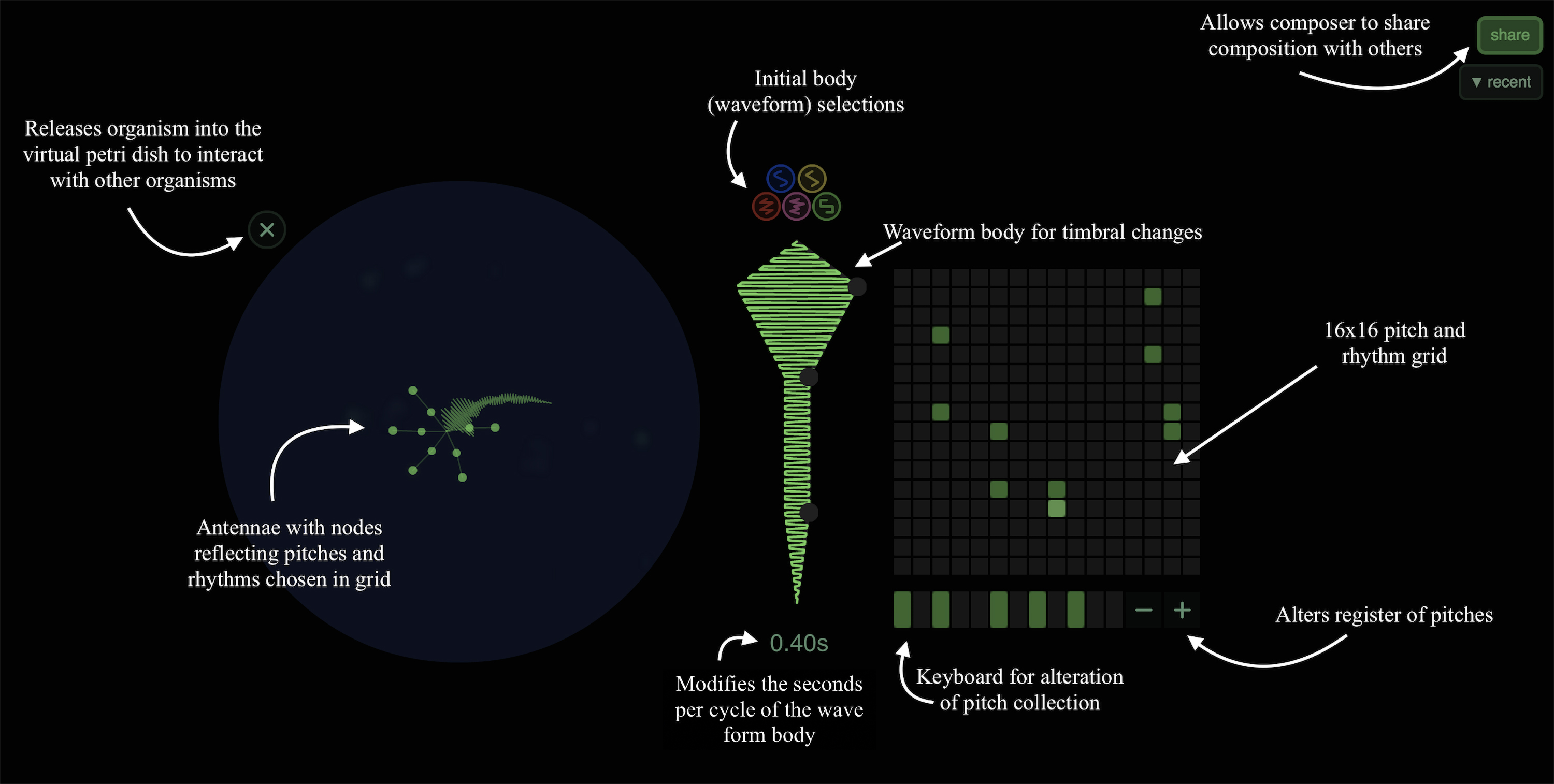Seaquence: Music Composition through Play and Virtual Biology. Mobile app for iOS app and website. Okaynokay, LLC. Released March 14, 2017. http://seaquence.org/ Free for basic version. $6.99 for all features.
Seaquence is a composition game, available both as an iOS app and a website, whose name cleverly combines a musical term with the image of the virtual watery environment in which it is based. In Seaquence, players create micro-organisms whose bodies possess and generate musical qualities. Each organism’s body consists of a soundwave whose amplitude and wavelength can be manipulated to shape, both musically and visually, its timbral characteristics. Composers can also choose between five different initial sound profiles, four pitched and one percussive, which are differentiated by color. The actual musical content is created by adding antennae and nodes to each organism via a 16x16 grid. The vertical or y-axis controls rhythm and the horizontal or x-axis controls pitch. A composer creates a pitch by clicking on a box within the grid and activating it. The 16 boxes of the y-axis limit the composer to a 4/4 meter, divisible by up to 4 sixteenth notes per beat. However, the pitch content of the x-axis has broader compositional potential. Its default pitch content is an anhemitonic pentatonic scale, lacking any half steps. As a result, the composer is set up for their composition to sound (relatively) consonant and what the average listener would likely deem aurally pleasing. Using a keyboard-like set of keys below the grid, composers can create complexity beyond the pentatonic environment. The plus/minus next to the keyboard allows composers to raise and lower the octave register of each organism’s pitch collection. When a composer has fully constructed each organism, it can be released to swim freely in a virtual petri dish and perform their riff with other organisms created by the composer. (See Example 1)

Example 1: Diagram of the Components of Seaquence (Screenshot from http://seaquence.org)
Seaquence’s pitch flexibility gives it a broad range of compositional possibilities. Its default pentatonic setting situates beginning composers for immediate gratification. In this mode, even random note selection within the grid creates pleasing and interesting grooves. Seaquence’s expandability into more complex pitch systems gives it the range necessary for more complex harmonic and melodic relationships. The pitch content can encompass a fully chromatic collection or any structure of intervallic relationships within the octave, and each musical organism may comprise a unique pitch collection. As each musical organism is created independently and then released into the virtual petri dish to interact with the others to create a full musical composition, their musical interactions can vary widely within the spectrum of contrapuntal relationships, both consonant or dissonant, harmonious or discordant.
Seaquence’s uses are broad, from a simple musical game for children to a musical instrument for use in complex mixed-media compositions, and that flexibility is perhaps its most notable feature. The selection of pitches within a grid and its playful visual aspect make it user-friendly to even the youngest musicians. It has tremendous potential for teachers and music education students in the elementary school classroom. Elementary students can use it both independently and in a guided context, where the instructor highlights different musical elements as the class cooperatively creates their organisms. It also can be used as a pedagogical sound canvas for more advanced theory or composition students to explore different pitch relationships. All modes, including octatonic, hexatonic, and whole tone are possible within the Seaquence system. This potential for complexity and the matrix-like organization of its compositional grid provide students with an interesting canvas on which to explore intervallic relationships inherent within each pitch collection. Each organism can be limited to any size collection, so students can also explore the qualities of individual set classes or the interactions between different set classes within a post-tonal class as well as tonal relationships within earlier courses in the standard theory sequence. For assignments within a theory class, each composition is shareable, creating a unique web-address that could be sent to an instructor as an assignment or sent to collaborators for further alteration, a useful component in both classroom and professional settings. As a tool beyond the classroom, composers can use it as a free-standing compositional device with a visual component as an additional performance element or as a mixed-media construct, adding to other electronic or acoustic instruments in performance.


